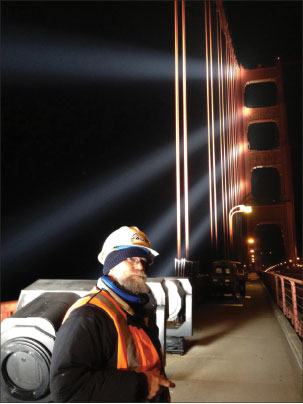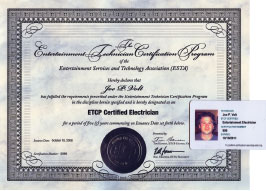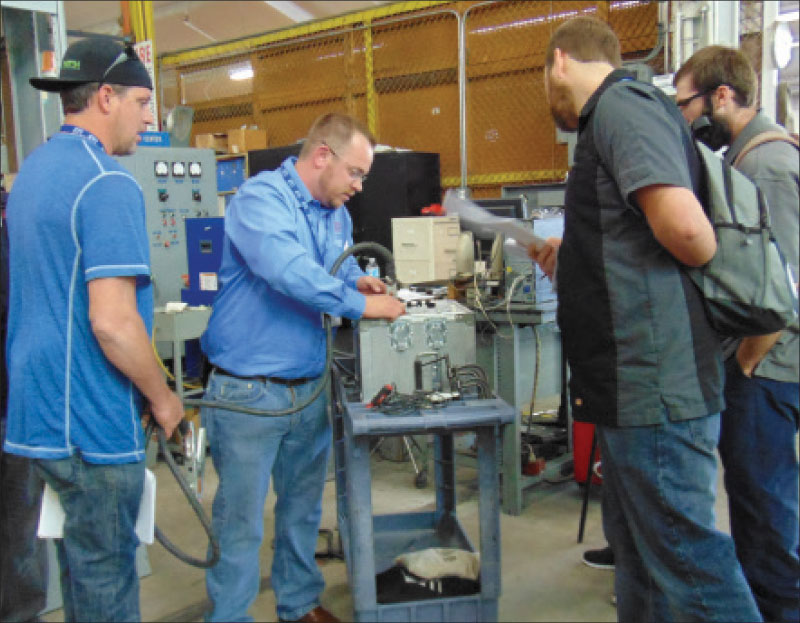Entertainment comes from a magical space. Through the mediums of live and recorded arts, the mind is transported to new levels of excitement, fantasy, and adventure. As the entertainment industry strives to reach even higher levels in this magical space, the boundaries of science are constantly being stretched. The entertainment industry is known to take unconventional paths to attain magic, but the paths must be safe for the performers, the support staff, and the audience. Without these people there is no magic.
In the early 1980s, the United States Institute for Theatre Technology (USITT), the association of design, production, and technology professionals in the performing arts and entertainment industry formed 53 years ago, realized that the entertainment industry was working with a National Electrical Code from the 1920s. Marble slab switchboards and resistance dimmers requiring hoods to keep the scenery away from the hot resistance plates were no longer the industry standard or even commonplace. USITT began to work with the electrical inspection community to update codes and standards in order to make them safely relevant and workable. The entertainment industry, in defense of some of its unconventional proposals, offered that their people were trained professionals. The inspection community would counter with “How do you know your people are trained professionals?” The entertainment industry answered the question seven years ago by providing opportunities for certification.
This article describes the creation of a dual-focused program created under the rubric of the Entertainment Technician Certification Program (ETCP). The two spheres currently covered by the program are rigging and electrical work, as industry leaders determined that these areas are the most vulnerable to accidents which can lead to serious and sometimes fatal injury.
Recognizing that the area of electrical skills will be of most interest to IAEI members and readers, this discussion will focus largely on that subject. However, first a bit of history to provide a context in seeing how this electrical skills certification program came to be. What follows is a brief background on how the program began under the auspices of the Entertainment Services and Technology Association (ESTA).
Establishment of the Entertainment Technician Certification Program (ETCP)
It was past experience and knowledge regarding the probable dangers of entertainment production that motivated the board of directors of ESTA to establish ETCP in March 2003. One goal was to establish a system of internal industry checks to assure that all reasonable caution is taken in entertainment venues and that our work force is supervised by lead workers who meet the criteria of being “qualified individuals.” ETCP was formed with the intention to attract the top-third of riggers and entertainment electricians who would oversee the hundreds of thousands of permanent and temporary installations that occur each year in this country.
Control of ETCP lies directly in the hands of the ETCP Certification Council, made up of major elements of the North American entertainment world (see sidebar). Council members represent most of the major trade and professional associations, key employers, knowledgeable individuals, and the chairs of the relevant subject matter expert groups that created the certification examinations. As an aside, in 2012, ESTA merged with its European counterpart, PLASA, and operates now as PLASA North America. PLASA is the
leading international trade association for those who supply technologies and services to the event, entertainment and installation industries. PLASA now maintains the ETCP in North America and the National Rigging Certificate (NRC) in Europe. The UK and the US have very different standards for how certification (or qualification) programs are created and operated, so it was necessary for each program to address their unique legal, liability and geographic
considerations.
Certification programs are extremely expensive to develop and maintain, so it was necessary to raise substantial amounts of money to establish the program. With a cost in excess of a quarter-million dollars to create just one test, the initial investment was sizeable. Each of the organizations and businesses holding seats on the Certification Council made significant contributions as did many members of ESTA. The target goal was always to have the program become self-sustaining, and at this time the number of candidates (over 1600 certified to date) has made this hope a reality.

Photo 1. Joe Hatch, ETCP Certified, lighting the Golden Gate Bridge
As stated earlier, initial conversations identified two disciplines as being of substantial interest and involving a population large enough to support a certification endeavor: Rigging and Electrical. With its determination that rigging was the field that involved the most risk, ETCP first concentrated on that area, but divided the specialty into two distinct populations: theatrical (auditorium-based performance venues) and arena (touring shows, circuses, and similar ventures).
The development of certification programs involves an assessment process that recognizes an individual’s knowledge, skills and competency in a particular specialty. The oversight body must ensure that all credentialing programs and their examinations are developed and conducted according to legally defensible and generally accepted psychometric principles and standards.
To assure absolute legitimacy, the process used in the development of ETCP followed theNational Commission for Certifying Agencies’ Standards for the Accreditation of Certification Programs. ETCP
was formed and its actions guided by recognized certification experts and psychomatricians, the latter being the nationally-acclaimed firm, Applied
Measurement Professionals (AMP). A staff person who was trained in statistics and psychometrics was hired to guide the ETCP office work and support the Council members. Subject matter experts (SMEs), one group for each emphasis, were recruited from among the industry’s leading practitioners and work commenced immediately to identify a body of knowledge that would guide the development of test questions. For the most part both rigging SME groups used a parallel time frame and the first set of tests was conducted in 2005. While these were paper and pencil exams, still given to groups of 10 or more,
nowadays exams are more typically taken by individuals at registered computer-based testing sites.

Photo 2. ETCP certificate with ID photo
Electrical Skills Certification
The electrical skills exam was unveiled in 2007. Test development followed the same approach, principles and pricing that was used for the rigging certifications. Again, the focus is on attracting the top-third of practicing entertainment electricians. This
certification encompasses the installation, interconnection, safe use, and repair of all portable distribution; utilization of entertainment industry related electrical equipment; and the safe use of all venue electrical equipment. Additionally, this certification encompasses the design, layout, and interconnection of portable electrical distribution equipment, including generation if necessary, as well as the safe connection of portable distribution feeders to fixed power sources. Applicants will be expected to know electrical theory and the safe installation and use of entertainment electrical equipment.
ETCP has prepared candidate handbooks which describe the entire process in great detail. The candidate information for all three examinations can be found on the ETCP website, but the Electrical Skills Handbook can be found at:
http://etcp.plasa.org/candidateinfo/electricalexams/docs/ETCP_Electrical_Handbook_V2.pdf.
Test subject matter content is detailed in an outline located at the center of the handbook. The handbook notes that each exam includes questions based on every topic listed, as well as the number of questions that address each specific category.
Questions were written based on the principle that candidates need to be able to know and apply knowledge in three ways:
1.
Recall: The ability to recall or recognize specific information.
2. Application: The ability to comprehend, relate or apply knowledge to new or changing
situations.
3. Analysis: The ability to analyze and synthesize information, determine solutions and/or
evaluate the usefulness of a solution.
Any certification program must be independent of any teaching, coaching activity or knowledge depository. The content outline, however, provides a scope that candidates can use to evaluate their personal knowledge and experience and guide their own study (see sidebar for an abbreviated listing).
The handbook also includes three sample questions and ETCP has created practice examinations that include 50 representative questions and are available at http://etcp.plasa.org/practiceexams.
These practice exams have proven to be a big confidence booster for candidates who generally have some degree of test anxiety. To combat some of this concern, The ESTA Foundation provides a bibliography of texts that might be useful in reviewing for the test and provides a list of seminars that might be helpful in preparation. Both of these
are available at http://www.estafoundation.org/seminars/resources.htm.
Candidate Qualifications
In order to take the test, candidates must meet a criterion of 30 points that can be earned through various means such as undergraduate and graduate degrees, internships, and similar activities. The most important element in qualifying to sit for the exam is practical field experience and even though formal educational credits will help, most of the points must be derived from work experience. All information submitted on the application must be verified by employers, institutions, and labor providers.
Renewals
Certifications must be renewed every five years, because ETCP wants to encourage continued education in the field. To this end, ETCP has established a category of ETCP Recognized Trainers, Training Programs, and Training Providers. These individuals or companies must submit credentials and syllabi that inform ETCP as to what their programming will provide in terms that clarify its relevance to renewal candidates.
ETCP Has Influenced the Industry
The idea of hiring the best of the best has worked its way into numerous contracts at major convention centers and performance venues across the nation. While there still exists a need for growth, it is safe to say that the entertainment industry has embraced the program and made it a lynchpin to further the strength of technician skills and
to encourage ongoing education. There are ETCP Recognized Employers, Contractors and Labor Providers who sign a Best Practices agreement which indicates their commitment to use Certified Technicians. These companies and organizations advertise their proud association with ETCP and the quality of work and skills ETCP certificants provide.
One of the services provided on the ETCP website is a North American map which allows someone seeking qualified workers to find them at the click of a mouse. Clicking on a state or province will bring up a list of names with company associations, union affiliations, and certifications, along with the dates certifications were granted and when they expire. While the majority of certificants hold only one certification, there
are quite a few with multiple credentials and more than a dozen who hold all three certifications.
We hope that by informing IAEI members of ETCP’s existence, cooperative efforts may emerge that will strengthen both organizations’ ability to provide our labor force
with safe work practices and increase their skills as our technology grows more
sophisticated. The number of accidents that has occurred in the last couple of years has made us aware of both the opportunities and the challenges that face all of us in the future. With certification, the entertainment industry stands prepared and actively engaged in making certain that our profession is safe for participants and audiences alike.
Certification Council Membership
ORGANIZATIONAL MEMBERS (10)
PLASA
ACTSAFE
Alliance of Motion Picture and Television
Producers (AMPTP)
The Broadway League
Canadian Institute for Theatre Technology (CITT)
InfoComm International
International Alliance of Theatrical Stage
Employees (IATSE)
International Association of Venue
Managers (IAVM)
The League of American Theatres and Producers
Themed Entertainment Association (TEA)
United States Institute for Theatre Technology (USITT)
BUSINESS MEMBERS (6)
Broadway Across America
Cirque du Soleil
Disney Theatrical Productions
Live Nation
NBC Universal
Production Resource Group
SME CHAIRS
Electrical Skills – Alan Rowe and Ken Vannice
Rigging Skills – Karen Butler (Theatre)
and Bill Sapsis (Arena)
1. ELECTRICAL SKILLS, 75
A. APPLY ELECTRICAL THEORY, 10
• Calculate formulas using electrical principles and alternating current theory and applications
• Apply operational theories of SCR dimmers, basic electronics, and power supplies
• Perform operations and procedures with electrical metering tools, e.g., multimeter, ground tester, DMX tester, network/Ethernet tester
B. HANG/RIG OVERHEAD EQUIPMENT, 10
• Calculate weights of electrical equipment
• Specify equipment hanging techniques
C. SET UP ELECTRICAL SYSTEMS, 15
• Portable power distribution equipment, generators/transformers
• Lighting equipment and practical set fixtures
• Equipment addressing (e.g., scrollers, dimmers, moving lights)
• Basic special effects (e.g., fog/haze, water, snow, strobes)
• Branch circuit wiring for multiple purposes and safety ground connections
• Tie in feeder cables: bare end and single-pole locking connector














Find Us on Socials